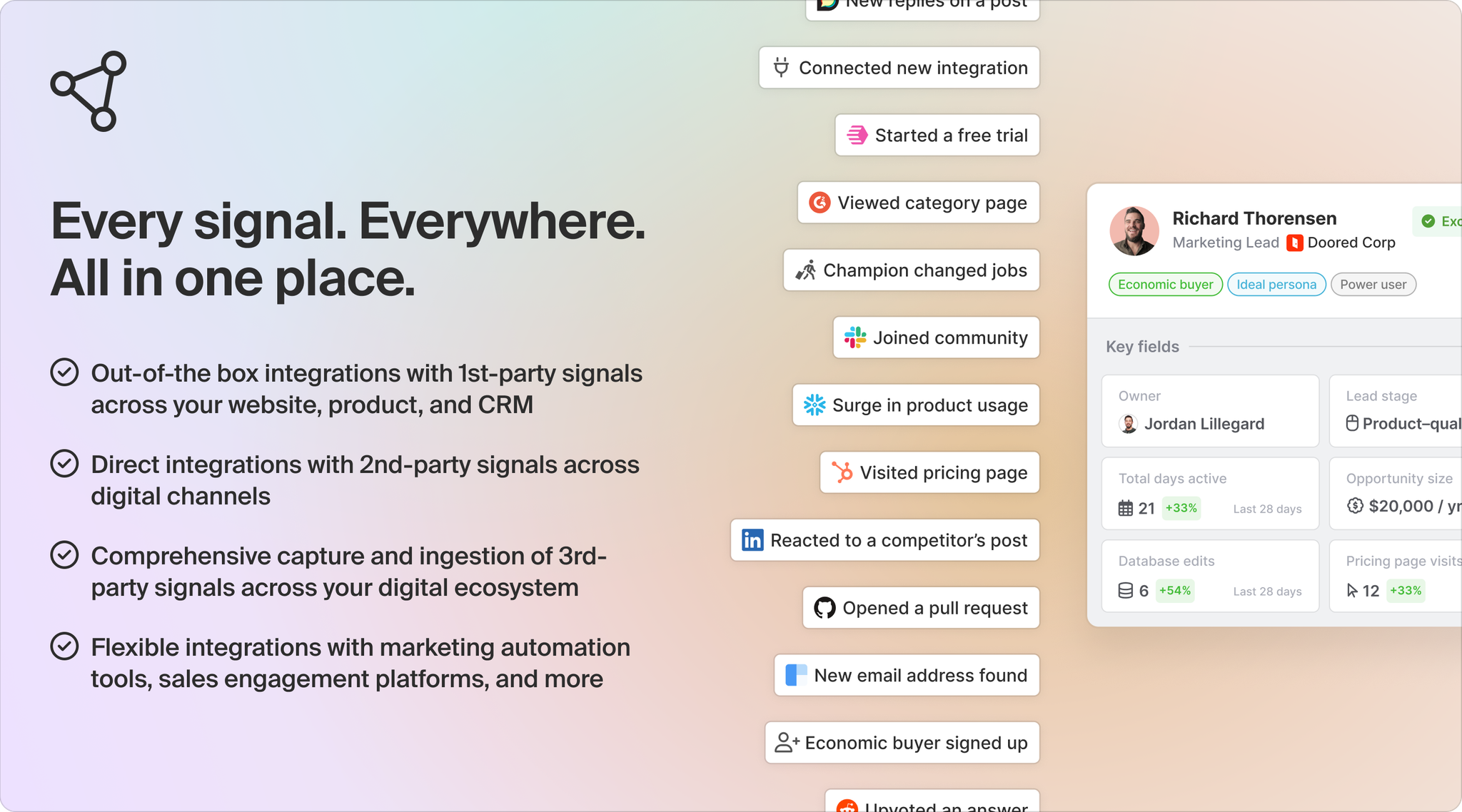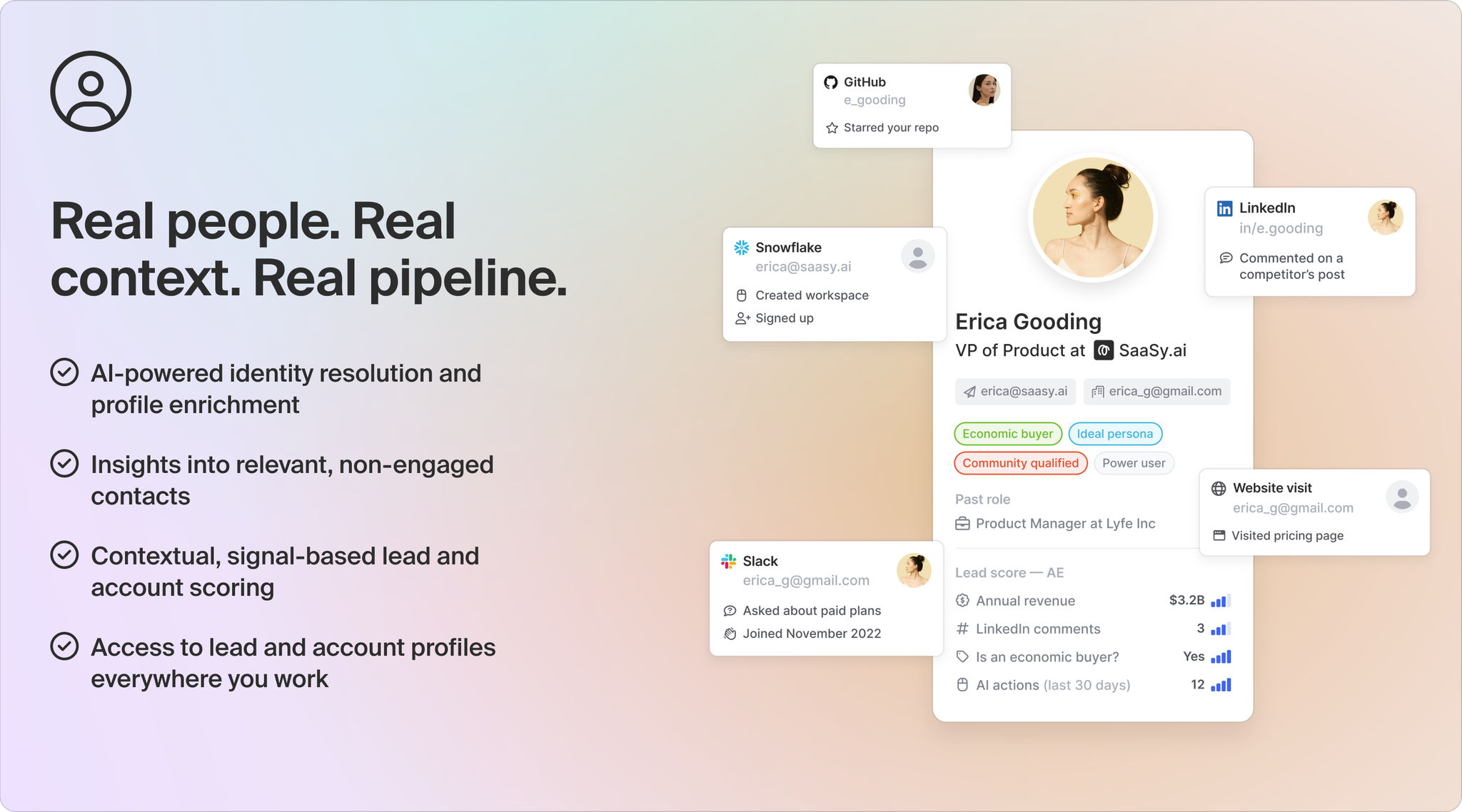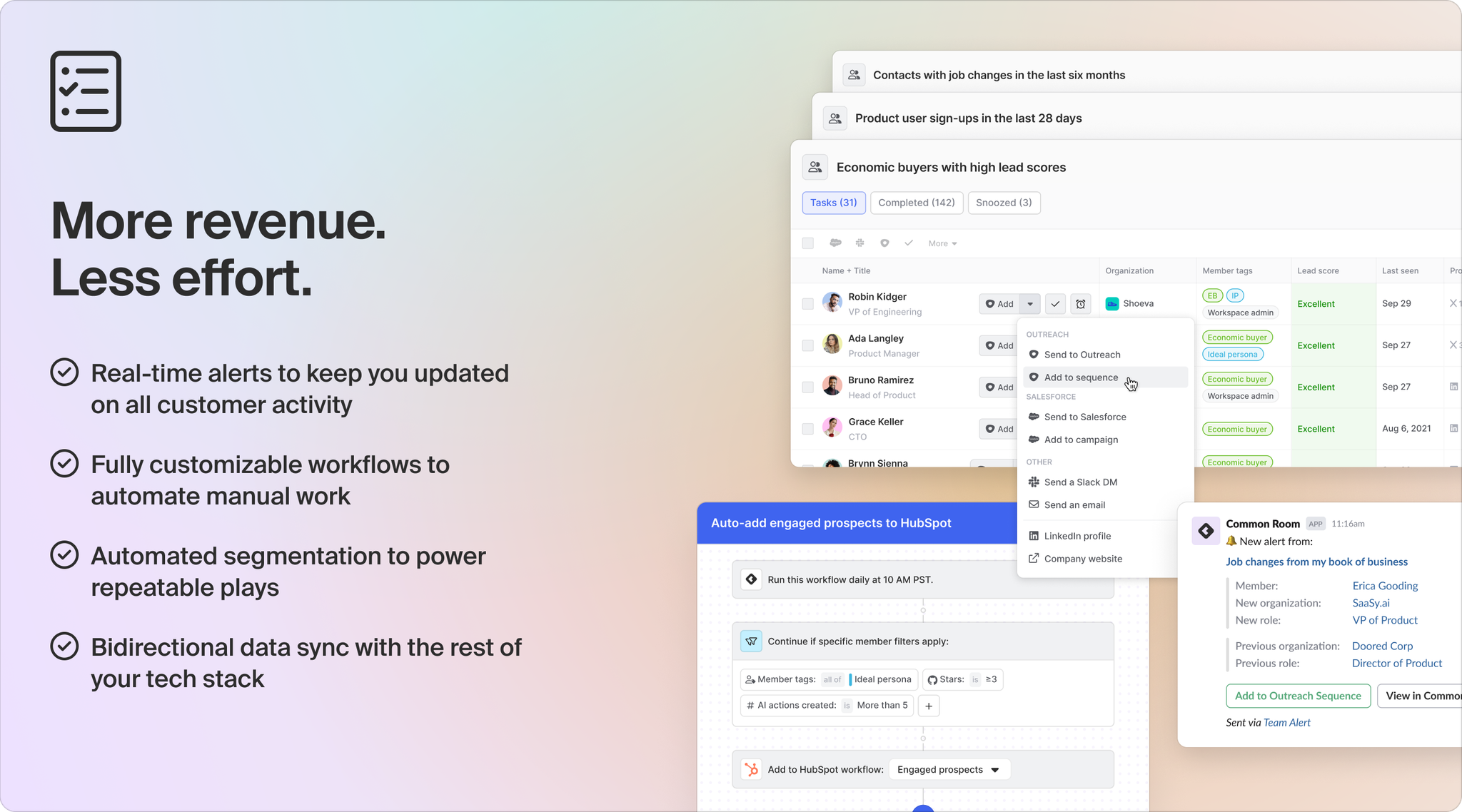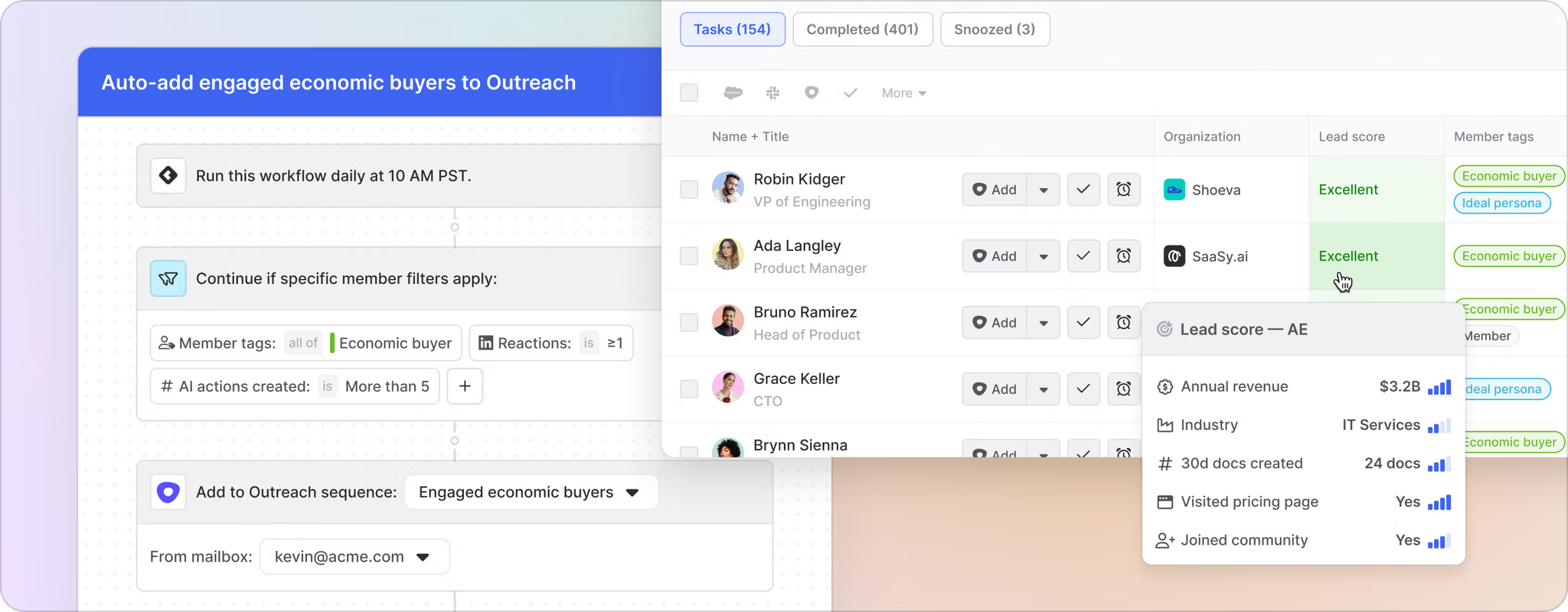We started Common Room to transform how organizations connect with people. Our customers transformed us.
Our work began in community and developer relations. We saw cutting-edge companies like Figma, Asana, dbt Labs, and dozens of others rewriting the go-to-market playbook. We saw them turning product users into product champions. And we saw them building a new type of growth engine in the process.
But we also saw them struggling.
Community and DevRel teams had no tools—they were fighting fires while working out of spreadsheets. So we set out to build what they needed.
And then a funny thing happened: As they connected their work to the efforts of the wider GTM org, their teammates started exploring how they could drive business outcomes using Common Room.
We heard from hundreds of teams across the GTM spectrum: sales leaders at Temporal, growth marketers at Amplitude, customer success reps at Notion, RevOps managers at Apollo GraphQL.
It was clear the problems we were solving for community and DevRel were being felt in every corner of GTM.
No matter the company, no matter the team, everyone was in search of the same solution:
One place where every buyer and customer signal, no matter the source, is automatically captured.
One place to connect those signals to a unified profile for every person and account.
And one place to automate last-mile actions on those signals and rapidly iterate.
We listened. We dug deep into our customers’ pain points and goals. And we applied those learnings to our product.
The result is the first of its kind: a customer intelligence platform—built for GTM teams, by GTM teams—that has end-to-end signal capture, person-first visibility, and workflow automation at its core.
The future of GTM is being invented as we speak—and it’s our customers who are leading the charge.

Innovation requires new ways of thinking
Here’s what I’ve learned after countless customer calls: Most GTM teams are either blind to the majority of buying signals, have no way to connect the dots between those signals and the customer journey, or are unable to act on them.
It’s no secret that the customer journey keeps getting cloudier and more fragmented. In fact, it’s something our original customers in community and DevRel are intimately familiar with.
Communities—no matter where they live—are inherently messy. And anonymity is often a feature, not a bug. So lack of visibility into people and their actions across channels was a challenge from the get-go.
But as the dark funnel gets darker, organizations are waking up to how broken GTM truly is.
Companies adopt endless point solutions in an attempt to fix the problem, but it only compounds it. GTM teams jump from interface to interface trying to piece together a patchy view of the customer. They spend hours stitching together disjointed data points—and more time struggling to take action on what they find.
If they’re lucky, they get access to confusing dashboards built by overworked data teams. But they can’t see the people behind the bar charts.
More often than not, they’re either incapable of accessing the insights they need or inundated with a firehose of data that causes analysis paralysis.
The trouble stems from legacy technologies that have become entrenched in GTM. These tools were built for an earlier era, one that was focused on linear sales funnels, account-level data, and spray-and-pray strategies. Person-level insights and modern buying behaviors weren’t part of the equation.
Every new piece of GTM tech is built around them and their outdated data structures. So each point solution that enters the market aims to treat a symptom of the problem instead of the underlying cause.
We avoided this trap because our product wasn’t built around that paradigm. We were working with organizations that needed a person-first, cross-channel view of customers far outside the bounds of what traditional tools could offer.
If the last 25 years of GTM have been about digitizing Rolodexes and chasing account-level “intent,” the future is what our customers are doing today.
Our customer intelligence platform is designed to help every GTM team do the same.

GTM can be fixed
Most organizations run their GTM operations using dozens of point solutions built on top of their CRMs, data warehouses, and marketing automation tools.
Many of these technologies go unused or offer a sliver of insights instead of the whole picture. They create bloated tech stacks that are essentially held together with duct tape. And, worst of all, they don’t solve the issues plaguing GTM teams:
Siloed and unseen signals
Customer and account signals—owned first-party signals, unowned second-party signals, and inferred third-party signals—are siloed across multiple technologies or hidden in the dark funnel, making GTM teams fully reliant on stretched-thin operations teams for basic insights. Worse yet, most martech and salestech misses 90% of the modern funnel.
One of our customers, a leader in video editing software, told us that 60% of any given sales rep’s time is spent cobbling together context for personalized outreach instead of actually selling. Missed pipeline opportunities—and, even worse, missed revenue targets—are the norm.
Identity blindness
Spotting signals is hard enough. Getting visibility into the people behind them and connecting the dots across channels is next to impossible. GTM teams lack key context and end up chasing account-level info that fails to generate quality opportunities, conversations, or relationships.
One of our customers, a leader in workflow automation software, told us how connecting with the right personas contributed to 62% of overall revenue and 44% higher annual contract values, but that customer-facing teams spent most of their time reaching out to the wrong stakeholders. High-intent, high-fit opportunities fall through the cracks.
Manual workflows
The last mile from data to action requires GTM teams to stitch together data and push it from one tool to another. The best performers try their best with user-unfriendly tools. The rest settle for the status quo.
One of our customers, a leader in security software, told us that the data its teams need access to for sales, marketing, and success is split between multiple tools—unenriched, unmapped to specific accounts, and inaccessible to the GTM org. Planning and launching plays requires massive effort from ops and hours of context-switching from GTM teams.
When our Head of Marketing, Kevin White, shared a resource highlighting the sheer breadth of modern signals available to GTM teams (100 of them, in fact) on LinkedIn, the response was overwhelming.
Every organization is hungry to succeed in this new era of GTM.
But as our customers told us, in order to do that, you need:
- Signal collection: Capture and ingest signals from across channels in one place.
- Unified identity: Connect those signals to real people and the places where they work.
- Workflow automation: Explore, action on, and automate responses to those signals at scale.
That’s exactly what our customer intelligence platform delivers—all in a fully customizable package with a user interface designed specifically for GTM practitioners.

Go to market intelligently
Common Room democratizes customer intelligence for every GTM team by providing a unified, person-first view of the entire customer journey across every touchpoint. More than that, we give teams the tools they need to take action on it fast.
Here’s how our customer intelligence platform makes every member of GTM—from sales to marketing to community to CS to ops—a top performer:

Digital signal capture
Buyer and customer signals are everywhere, from owned, first-party data sources like your product, website, and CRM, to second-party data sources like social and community channels, to third-party data sources like job listings, news and events, and intent vendors.
Common Room automatically captures all of them to give you a complete picture of your prospects and customers.
Instantly alert Salesforce account owners in Slack when a job change has been detected among current champions and customers.
Automatically add budget holders at accounts seeing a surge in product usage to personalized Outreach sequences.
Immediately plug anyone who engages with a competitor on social into a tailored HubSpot campaign.

“Common Room gave us visibility into multiple signals to identify new, relevant stakeholders—as well as their activity across several platforms—to target new leads and gain insights into accounts sales reps couldn’t see before. We made Common Room the hub for all the signals that would point to an ideal customer profile.”

Aisha Nins
GTM Program Manager
Our customer Apollo GraphQL uses our flexible, out-of-the-box integrations to centralize previously siloed and hard-to-see signals in one place.
Dark-funnel signals from open-source repositories, social channels, online forums, and more are combined with website engagement data, product usage insights, and CRM records. GTM teams never miss a signal.
Visibility into this activity helps Apollo GraphQL drive 26% of qualified leads.

Unified identity and account intelligence
Signals aren’t valuable unless you can see the person behind them—their title, seniority, and whether they belong to an account worth paying attention to.
Common Room’s Person360™ provides an intuitive, 360-degree view of every interaction across the modern customer journey and connects it to a real person and account.
Automatically tag and identify anyone with a director-level or above job title as an economic buyer.
Easily add demographic and firmographic behavioral data to lead and account scores.
Go beyond waterfall enrichment to achieve the highest match rate (50%) and accuracy (90%-plus) in the industry.

"Common Room has made it easier for our SDRs and AEs to book more and better meetings. It’s our favorite sales tool here. One of our AEs called it 'my closest friend.'"

Tyler Hayden
Director of Sales Development
Our customer Pulumi uses our AI-powered identity resolution and enrichment engine to match, merge, and enrich signals from every channel where buyers and customers are active.
Signals are synced to a unified identity and account that reveals job title, work history, contact information, firmographic fit, recent activities across digital channels, and more. GTM teams quickly zero in on high-intent, high-fit opportunities.
Access to person-first insights helps Pulumi drive 27% of meetings booked.

Actions and automation
Signals are only as good as what you do with them—and how quickly you act.
Common Room enables you to customize, templatize, and automate plays based on any combination of signals to drive business outcomes at scale.
Automatically add prospects who interact with website content to customized burn-down lists.
Send real-time notifications to reps when economic buyers join target accounts in the product.
Effortlessly send a personalized DM to ideal personas who join a community.

“Common Room is the future of connecting with your customers. My global CS team can instantly click into an account, view a complete profile of every user, and get total visibility into their behaviors across channels. We can quickly build, execute, and iterate on scaled engagement plays targeting the right people at the right time.”

Monica Perez
Head of Customer Success
Our customer Notion uses our segments, real-time alerts, and customizable workflows to quickly take action on buyer and customer activity.
High-fit product users and ideal personas are automatically added to dedicated burn-down lists segmented by region and account ownership in Salesforce. Real-time alerts keep teams updated on economic buyer activity and recent job changes. And automated workflows empower teams to tag people and accounts for different plays, add them to personalized email sequences, and much more. GTM teams act on customer intelligence instantly.
Leveraging prebuilt templates and powerful automations helps Notion make sure teams always reach out to the right person with the right message at the right moment.
We know that no two teams are exactly alike—each needs the freedom to adapt their data models and workflows to their ways of working in an instant, without waiting for permission or resourcing from other teams.
Common Room’s intuitive UI treats GTM users as first-class citizens, making it easy to gather timely insights, pinpoint high-value opportunities, and take action without dependence on technical teams.

We’ve seen firsthand how transformative a customer intelligence platform is for our customers.
Sales teams can boost rep productivity, generate more pipeline, and, ultimately, hit their revenue targets.
Marketing teams can grow the top of the funnel with signal capture across dark-funnel touchpoints, take a more informed approach to account-based programs, and show the impact of their investments in what were once hard-to-track channels.
Community and DevRel teams can automate manual tasks to focus and prioritize high-value activity, deliver better experiences to prospects and customers, and show business impact without having to stitch everything together in spreadsheets.
Customer success teams can proactively spot churn risks, build stronger customer relationships, and fuel account growth.
And operations teams can consolidate unused point solutions, reduce operational burdens on themselves and GTM teams, and deliver actionable insights that accelerate the trajectory of growth.
The new breed of data-driven GTM leader is rewriting the playbook for how modern organizations go to market.
They’re only getting started—and we’re thrilled to be the first platform to help them turn their vision into reality.
Every signal, everywhere. Tied to a unified identity. Made actionable and automated.
The future is here—and it’s powered by the Common Room customer intelligence platform.
Thank you to Roomies Kevin White, Bowen Pan, and Eric Wendt for the collaboration.
Unlock intelligent GTM with Common Room
Get started for free or get in touch to see how Common Room’s customer intelligence platform can help you transform sales, marketing, community, customer success, operations, and so much more.
